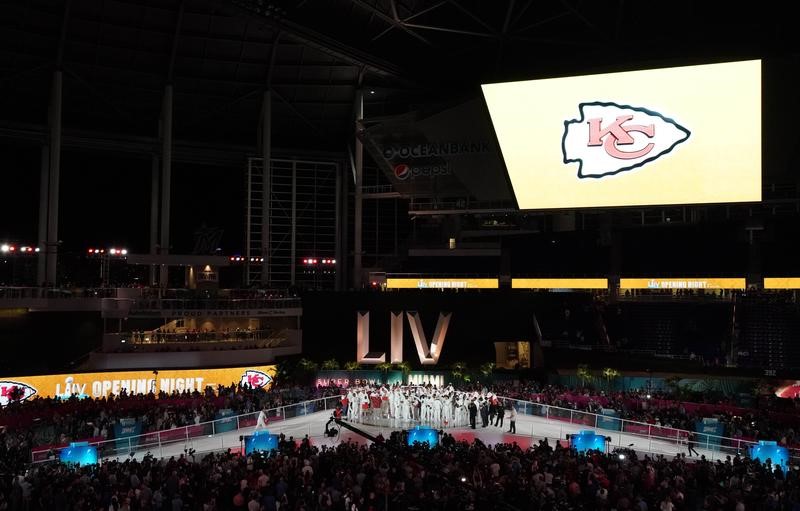By Amy Tennery
MIAMI (Reuters) - When the Kansas City Chiefs take the field at Hard Rock Stadium on Sunday, thousands of fans will see the culmination of five decades of striving for the NFL's ultimate stage: the Super Bowl.
Advocates for Native Americans, meanwhile, say it will be a stark reminder of how far they have to go.
From their team name and logo, to their home in Arrowhead Stadium, the Kansas City Chiefs bear the name and iconography of Native Americans - and with that, carry traditions that critics say draw on offensive and racist stereotypes.
"It's the portrayal, imagery of the kind of warrior savage, the uncivilized kind of perception and stereotype that has unfairly lingered around Indian country for a really long time," said Kevin Allis, the CEO of the National Congress of American Indians, the oldest and largest American Indian and Alaskan Native advocacy organization.
"I think the Kansas City Chiefs are getting a little more visibility now because they're in the limelight and we'll probably see more of it.
"As we see more and more of it on TV, it's going to be an issue."
Longstanding traditions like the "tomahawk chop," a chant that involves fans waving their arms through the air in a chopping motion, have drawn increased scrutiny in the lead up to the Super Bowl, along with other fan behavior like donning headdresses either in the stadium or at the tailgate parties outside.
Reached by email, the Chiefs said in a written statement that they "engaged in meaningful discussions with a group comprised of individuals with diverse Native American backgrounds and experiences" in the past six years.
"Our goal has been to use our platform to create an awareness and understanding of Native American cultures, as well as celebrate the rich traditions of multiple tribes with a historic connection to our region," they added.
Elizabeth Glynn, the CEO of Travois, a consulting firm that works with Native American and Alaskan Native and Native Hawaiian communities, said incremental changes were not enough, and that without changing the team name entirely, little progress could be made.
"I'm not sure why there's this blind spot in American society about native American imagery and how sports teams are using it for profit," said Glynn. "Until you really do something to change the symbol, none of that bad behavior is going to go anywhere.
"We can all act like taking away one thing might make a difference but until they change the name, nothing will really change."
One sign of change on the local level came months before the Chiefs ever landed in Miami, when the Kansas City Star https://www.kansascity.com/opinion/editorials/article236882498.html advocated for an end to the chanting and chopping hand gestures in a November editorial that called the practice, "a bad look for Kansas City - and an affront to Native Americans."
Media coverage of the issue ramped up in the days leading up to the Super Bowl as well, with the New York Times running an opinion piece on Saturday with the headline, "My Culture Is Not Super Bowl Entertainment".
Vincent Schilling, an Akwesasne Mohawk journalist and editor, told Reuters via email that while he believed offensive stereotypes toward the Native American community were deep-rooted in sports, he believed progress was possible.
"I find a tomahawk chop to be extremely insulting because it is essentially a cartoon stereotype version of what a Native American is," Schilling wrote.

"As the information age of television fades into history and people become collectively less tolerant toward stereotypes, the teams will have no choice."